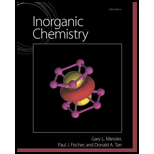
Concept explainers
Although
a. Propose a molecular orbital diagram, showing the interactions of the valence shell s and porbitals to form molecular orbitals.
b. Toward which atom would the HOMO be polarized? Why?
c. Predict the bond order.
d. Which is more electronegative, Kr or Br? Explain your reasoning.
Want to see the full answer?
Check out a sample textbook solution
Chapter 5 Solutions
Inorganic Chemistry
Additional Science Textbook Solutions
Chemistry & Chemical Reactivity
Chemistry
Organic Chemistry (8th Edition)
Chemistry: An Introduction to General, Organic, and Biological Chemistry (12th Edition) - Standalone book
Chemistry
Fundamentals of Heat and Mass Transfer
- Consider the following molecular orbitals formed from the combination of two hydrogen 1s orbitals: a. Which is the bonding molecular orbital and which is the antibonding molecular orbital? Explain how you can tell by looking at their shapes. b. Which of the two molecular orbitals is lower in energy? Why is this true?arrow_forwardThe molecular orbital diagram of NO shown in Figure 10.47 also applies to the following species. Write the molecular orbital electron configuration of each, indicating the bond order and the number of unpaired electrons. (a) CN (b) CO (c) BeB (d) BC+ Figure 10.47 Molecular orbital diagram for nitric oxide (NO). The molecular orbital diagram for NO predicts a bond order of 2.5 and predicts that the molecule is paramagnetic with one unpaired electron. These predictions are verified by experimental measurements.arrow_forwardWhich of the following molecules or ions are para-magnetic? What is the highest occupied molecular orbital (HOMO) in each one? Assume the molecular orbital diagram in Figure 9.16 applies to all of them. (a) NO (b) OF (c) O22 (d) Ne2+arrow_forward
- Why are d orbitals sometimes used to form hybrid orbitals? Which period of elements does not used orbitals for hybridization? If necessary, which d orbitals (3d, 4d, 5d, or 6d) would sulfur use to form hybrid orbitals requiring d atomic orbitals? Answer the same question for arsenic and for iodine.arrow_forwardShow how valence bond theory and molecular orbital theory rationalize the OO bond order of 1.5 in ozone.arrow_forwardBromine forms a number of oxides of varying stability. (a) One oxide has 90.90% Br and 9.10% O. Assuming its empirical and molecular formulas are the same, draw a Lewis structure of the molecule and specify the hybridization of the central atom (O). (b) Another oxide is unstable BrO. Assuming the molecular orbital diagram in Figure 9. 16 applies to BrO, write its electron configuration (where Br uses 45 and 4p orbitals). What is the highest occupied molecular orbital (HOMO) for the molecule?arrow_forward
- (a) Which one of the statements concerning valence bond (VB) and molecular orbital (MO) bond theories is correct? A. In VB theory, bonding electrons are delocalized over the molecule.B. MO theory accurately describes bonding in O2 and NO, VB theory does not.C. MO theory predicts that electrons are localized between pairs of atoms.D. MO theory is used to accurately predict the colors of compounds.E. VB theory can describe molecular bonding in excited states. (b) Refer to Diagram 9-1. Use molecular orbital theory to predict which species is paramagnetic. A. Li2B. H2C. F2D. O2E. N2 (c) Which combination of atoms is most likely to produce a compound with covalent bonds? A. Al and OB. Pb and FC. K and ID. S and BrE. Na and Cl (d) The central atom in the triiodide ion, I 3 –, is surrounded by A. one single bond, one double bond, and one lone pair of electrons.B. two single bonds and three lone pairs of electrons.C. two single bonds and no lone pairs of electrons.D. two single bonds and two…arrow_forwardThe nitrosyl ion. NO+, has an interesting chemistry. (a) Is NO+ diamagnetic or paramagnetic? Ifparamagnetic, how many unpaired electrons does it have? (b) What is the highest-energy molecular orbital (HOMO) occupied by electrons? (c) What is the nitrogen-oxygen bond order? (d) Is the N-O bond in NO* stronger or weaker than the bond in NO?arrow_forward1. a) Draw the dominant Lewis structure for the allene molecule (1,2-propyl diene, CH2CCH2 ) and use VSEPR theory to determine the molecule's geometry. In specifying the geometry give all bond angles and specify which nuclei lie in the same plane. b) Propose a hybridization and bonding scheme for the atoms in allene. That is, specify how each of the atoms is hybridized, which atomic orbitals overlap to form bonding molecular orbitals, and the nature (i.e., 0", 7f, etc.) of these molecular orbitals. c) Draw a plausible valence molecular orbital level diagram for allene (include only bonding MOs) based on the results from (b). d) Based on the work from (c) deduce the valence electronic configuration of the ground state of allene. e) Is the molecule planar or nonplanar? Explain your answerarrow_forward
 Chemistry: Principles and PracticeChemistryISBN:9780534420123Author:Daniel L. Reger, Scott R. Goode, David W. Ball, Edward MercerPublisher:Cengage Learning
Chemistry: Principles and PracticeChemistryISBN:9780534420123Author:Daniel L. Reger, Scott R. Goode, David W. Ball, Edward MercerPublisher:Cengage Learning
 ChemistryChemistryISBN:9781305957404Author:Steven S. Zumdahl, Susan A. Zumdahl, Donald J. DeCostePublisher:Cengage Learning
ChemistryChemistryISBN:9781305957404Author:Steven S. Zumdahl, Susan A. Zumdahl, Donald J. DeCostePublisher:Cengage Learning Chemistry: An Atoms First ApproachChemistryISBN:9781305079243Author:Steven S. Zumdahl, Susan A. ZumdahlPublisher:Cengage Learning
Chemistry: An Atoms First ApproachChemistryISBN:9781305079243Author:Steven S. Zumdahl, Susan A. ZumdahlPublisher:Cengage Learning Chemistry & Chemical ReactivityChemistryISBN:9781337399074Author:John C. Kotz, Paul M. Treichel, John Townsend, David TreichelPublisher:Cengage Learning
Chemistry & Chemical ReactivityChemistryISBN:9781337399074Author:John C. Kotz, Paul M. Treichel, John Townsend, David TreichelPublisher:Cengage Learning Chemistry & Chemical ReactivityChemistryISBN:9781133949640Author:John C. Kotz, Paul M. Treichel, John Townsend, David TreichelPublisher:Cengage Learning
Chemistry & Chemical ReactivityChemistryISBN:9781133949640Author:John C. Kotz, Paul M. Treichel, John Townsend, David TreichelPublisher:Cengage Learning





